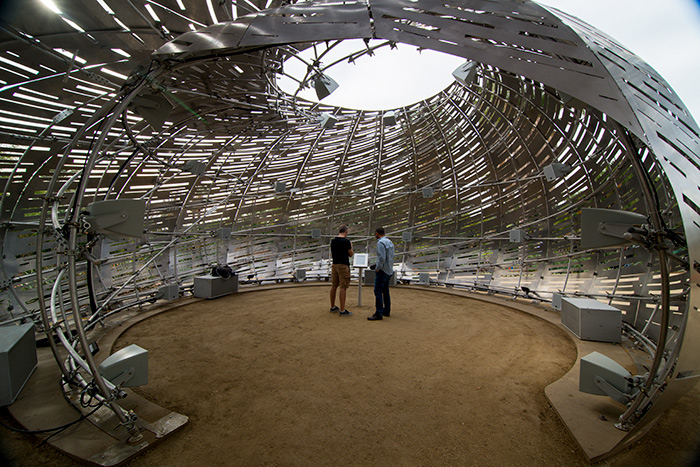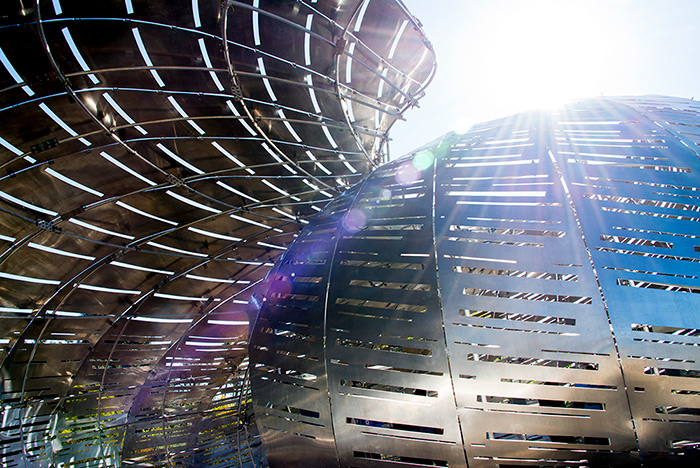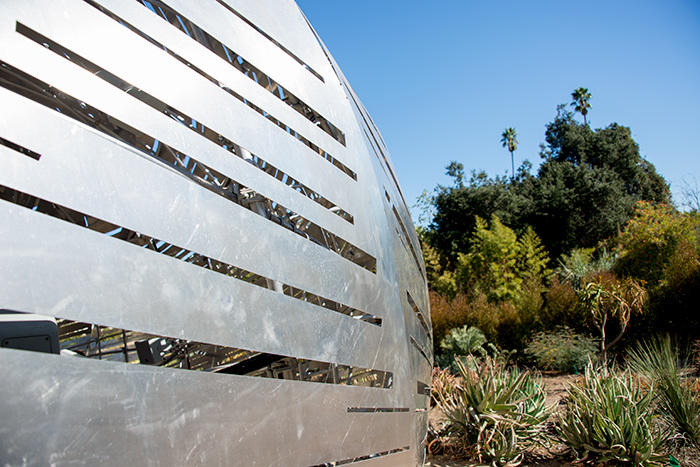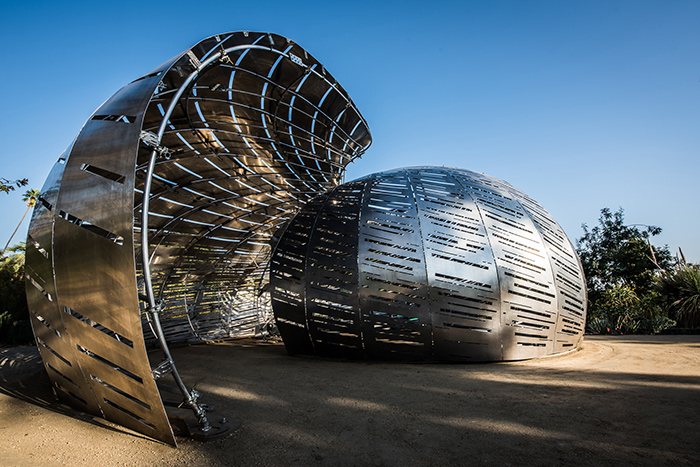As visual strategists at NASA’s Jet Propulsion Laboratory (JPL), Dan Goods and David Delgado use art and design to explain science. Their newest project is the Orbit Pavilion sound experience, which recently opened at The Huntington. The large silver structure sits on the Celebration Lawn by the terrace of the 1919 café. Inside, visitors can hear sounds representing the movement of the International Space Station and 19 Earth satellites. We asked Goods and Delgado about the thinking behind the project.

Dan Goods (left) and David Delgado test the iPad where visitors can determine which satellite is passing above their heads. Sounds from 28 speakers help visitors “hear” the satellites. Photo by Kate Lain.
Q: Why Earth science satellites?
Goods: Most people know JPL from the Mars missions. But about a third of what we do is related to Earth science. These satellites are constantly circling the globe, relaying information about land, atmosphere, and oceans. That data helps us understand things like earthquakes, the presence of hurricanes, the melting of glaciers.
Q: What was the genesis of this project?
Delgado: We were in the Mojave Desert touring Goldstone, one of three communications complexes NASA uses to track and guide missions in deep space. Here was this huge antenna doing this crucial work of relaying information to and from spacecraft and yet everything was silent. That got us thinking about ways to represent things that can’t be seen or heard.

The cuts in the panels represent the orbits of satellites, which circle the globe approximately every 90 minutes. Photo by Kate Lain.
Q: What exactly are we hearing in the pavilion?
Delgado: We worked with Oakland-based sound artist Shane Myrbeck to give each of the 19 satellites its own “voice.” There are two phases to the sound experience. One phase allows us to hear the satellites passing overhead in real-time—essentially the satellites saying hello to us in their own unique way. Depending on how many satellites are in orbit above you, you will sometimes hear more sounds than at other times. Then, in the second phase, Myrbeck created a one-minute composition representing the orbits of these satellites over 24 hours. The sounds are inspired by aspects of Earth’s ecology being studied in three categories: land, atmosphere, and ocean. For instance, the sound of the satellite Cloudsat, which tracks weather clouds, is represented by desert wind. Then there are sounds related to land and water. The only human voices are of a choir, representing the International Space Station.
Goods: An iPad tells you which phase you’re in, and if the sound is related to real-time data, the iPad’s screen will tell you which satellite you’re “hearing.”

JPL’s visual strategists contend that The Huntington is a “dream spot” to install the Orbit Pavilion. They love the natural setting and the presence of botanical collections from around the world. Photo by Kate Lain.
Q: The pavilion is a 30-foot wide structure made from bands of aluminum attached to a tubular frame. Why the seashell shape?
Delgado: We worked with designers Jason Klimoski and Lesley Chang of the New York design firm StudioKCA to come up with the nautilus shape. If you’ve ever held a seashell up to your ear, then you may remember listening to the “sounds of the ocean.” In this case, you’re listening to the sounds of satellites. It is visually striking and elevates the experience as a whole.
Q: What makes The Huntington a good setting for the Orbit Pavilion?
Goods: Part of Orbit’s message is ecology. We love the fact that Orbit is in a natural setting at The Huntington, surrounded by botanical collections from around the world. Then there’s the connection to the library collection. It’s amazing to think that rare books by early astronomers Galileo Galilei and Johannes Kepler are so close by.

The 72 panels of water-jet cut aluminum are bolted to the frame to create a double-curved shell. Photo by Dan Goods.
Orbit Pavilion is on view on the Celebration Lawn (across from the Celebration Garden) through Feb. 27, 2017. The Orbit Pavilion kicks off /five, a contemporary arts initiative focused on collaboration between The Huntington and five organizations over a period of five years. The aim is to engage with the Huntington’s library, art, and botanical collections in new and thought-provoking ways.
The /five initiative is made possible by a generous gift from The Cheng Family Foundation. Additional funding for Orbit Pavilion was provided by Kim and Ginger Caldwell and the Bry and Judi Danner President’s Discretionary Fund.
For more information on NASA’s Earth science satellites, visit the Mapel Orientation Gallery. You’ll find “Eyes on the Earth,” an interactive program on a large touchscreen, where you can learn more about what the satellites are tracking—such as sea level height or global temperature.
Diana W. Thompson is senior writer for the office of communications and marketing at The Huntington.
